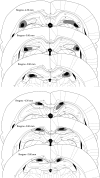Distinct roles for dorsal CA3 and CA1 in memory for sequential nonspatial events
- PMID: 20028733
- PMCID: PMC2807176
- DOI: 10.1101/lm.1616209
Distinct roles for dorsal CA3 and CA1 in memory for sequential nonspatial events
Abstract
Previous studies have suggested that dorsal hippocampal areas CA3 and CA1 are both involved in representing sequences of events that compose unique episodes. However, it is uncertain whether the contribution of CA3 is restricted to spatial information, and it is unclear whether CA1 encodes order per se or contributes by an active maintenance of memories of sequential events. Here, we developed a new behavioral task that examines memory for the order of sequential nonspatial events presented as trial-unique odor pairings. When the interval between odors within a studied pair was brief (3 sec), bilateral dorsal CA3 lesions severely disrupted memory for their order, whereas dorsal CA1 lesions did not affect performance. However, when the inter-item interval was extended to 10 sec, CA1 lesions, as well as CA3 lesions, severely disrupted performance. These findings suggest that the role of CA3 in sequence memory is not limited to spatial information, but rather appears to be a fundamental property of CA3 function. In contrast, CA1 becomes involved when memories for events must be held or sequenced over long intervals. Thus, CA3 and CA1 are both involved in memory for sequential nonspatial events that compose unique experiences, and these areas play different roles that are distinguished by the duration of time that must be bridged between key events.
Figures




Similar articles
-
Proximodistal segregation of nonspatial information in CA3: preferential recruitment of a proximal CA3-distal CA1 network in nonspatial recognition memory.J Neurosci. 2013 Jul 10;33(28):11506-14. doi: 10.1523/JNEUROSCI.4480-12.2013. J Neurosci. 2013. PMID: 23843521 Free PMC article.
-
Nonspatial sequence coding varies along the CA1 transverse axis.Behav Brain Res. 2018 Nov 15;354:39-47. doi: 10.1016/j.bbr.2017.10.015. Epub 2017 Oct 28. Behav Brain Res. 2018. PMID: 29107714 Free PMC article.
-
Perirhinal cortical inactivation impairs object-in-place memory and disrupts task-dependent firing in hippocampal CA1, but not in CA3.Front Neural Circuits. 2013 Aug 14;7:134. doi: 10.3389/fncir.2013.00134. eCollection 2013. Front Neural Circuits. 2013. PMID: 23966912 Free PMC article.
-
Mapping memory function in the medial temporal lobe with the immediate-early gene Arc.Behav Brain Res. 2013 Oct 1;254:22-33. doi: 10.1016/j.bbr.2013.04.048. Epub 2013 May 3. Behav Brain Res. 2013. PMID: 23648768 Review.
-
The role of hippocampal subregions in memory for stimulus associations.Behav Brain Res. 2010 Dec 31;215(2):275-91. doi: 10.1016/j.bbr.2010.07.006. Epub 2010 Jul 13. Behav Brain Res. 2010. PMID: 20633579 Review.
Cited by
-
Silencing CA3 disrupts temporal coding in the CA1 ensemble.Nat Neurosci. 2016 Jul;19(7):945-51. doi: 10.1038/nn.4311. Epub 2016 May 30. Nat Neurosci. 2016. PMID: 27239937
-
Timescales of learning in the basal ganglia and the hippocampus.Front Behav Neurosci. 2013 Aug 1;7:98. doi: 10.3389/fnbeh.2013.00098. eCollection 2013. Front Behav Neurosci. 2013. PMID: 23914163 Free PMC article. No abstract available.
-
Memory on time.Trends Cogn Sci. 2013 Feb;17(2):81-8. doi: 10.1016/j.tics.2012.12.007. Epub 2013 Jan 12. Trends Cogn Sci. 2013. PMID: 23318095 Free PMC article. Review.
-
Hippocampal formation-inspired global self-localization: quick recovery from the kidnapped robot problem from an egocentric perspective.Front Comput Neurosci. 2024 Jul 18;18:1398851. doi: 10.3389/fncom.2024.1398851. eCollection 2024. Front Comput Neurosci. 2024. PMID: 39092317 Free PMC article.
-
Altered synaptic structure in the hippocampus in a mouse model of Alzheimer's disease with soluble amyloid-β oligomers and no plaque pathology.Mol Neurodegener. 2014 Oct 13;9:41. doi: 10.1186/1750-1326-9-41. Mol Neurodegener. 2014. PMID: 25312309 Free PMC article.
References
-
- Amaral DG, Witter MP. The three-dimensional organization of the hippocampal formation: A review of anatomical data. Neuroscience. 1989;31:571–591. - PubMed
-
- Bliss TV, Collingridge GL. A synaptic model of memory: Long-term potentiation in the hippocampus. Nature. 1993;361:31–39. - PubMed
-
- Dragoi G, Buzsáki G. Temporal encoding of place sequences by hippocampal cell assemblies. Neuron. 2006;50:145–157. - PubMed
Publication types
MeSH terms
Grants and funding
LinkOut - more resources
Full Text Sources
Other Literature Sources
Medical
Miscellaneous
